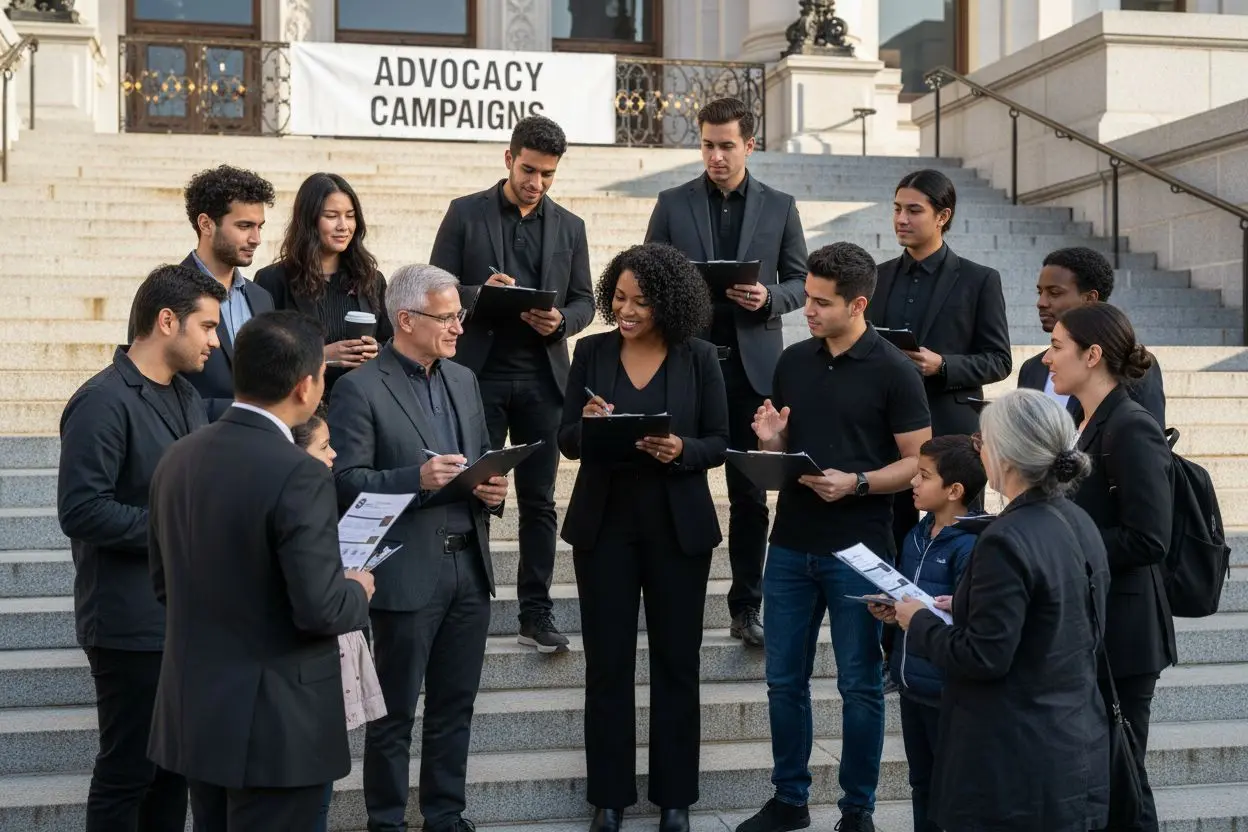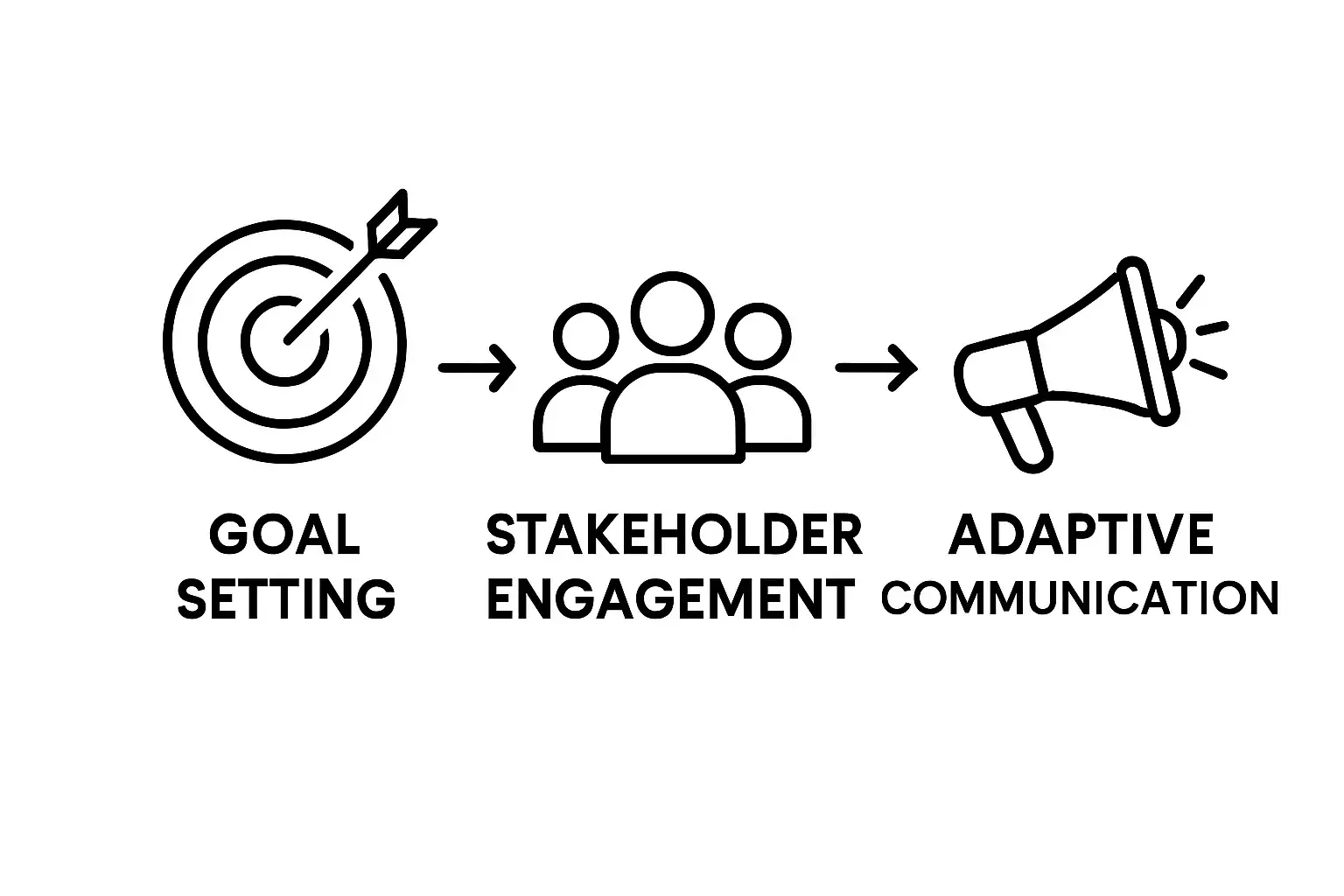Understanding Successful Advocacy Campaigns for Impact

Advocacy campaigns have reshaped societies and challenged unfair systems for decades. Some of the most iconic changes started with movements that seemed small but became unstoppable waves. Yet, research shows that the most impactful campaigns carefully combine clear messaging, multi channel strategies, and measurable outcomes to achieve success. The real surprise is how much strategy and structured planning sit behind every rallying cry for justice.
Table of Contents
- What Are Successful Advocacy Campaigns?
- The Importance of Advocacy Campaigns in Society
- The Mechanisms Behind Advocacy Campaigns
- Key Concepts and Strategies for Advocacy Success
Quick Summary
| Takeaway | Explanation |
|---|---|
| Define clear objectives | Successful advocacy campaigns must establish specific, measurable goals aligned with desired social changes. |
| Build coalitions effectively | Forming robust networks of diverse stakeholders enhances resource mobilization and campaign impact. |
| Emphasise community engagement | Genuine change arises from deep community connections; engage communities to amplify their voices. |
| Craft compelling narratives | Effective communication transforms complex issues into relatable stories, driving empathy and collective action. |
| Adopt adaptive strategies | Campaigns should remain flexible to adjust tactics and messaging based on evolving social dynamics. |
What are Successful Advocacy Campaigns?
Successful advocacy campaigns represent strategic efforts to drive meaningful social, political, or systemic change by mobilizing public support, influencing decision makers, and creating sustained momentum around specific issues. These campaigns are sophisticated endeavors that go beyond simple awareness raising, focusing on concrete actions and tangible outcomes.
Defining Advocacy Campaign Objectives
At their core, successful advocacy campaigns aim to create strategic shifts in policy, public perception, or organizational practices. They are carefully orchestrated initiatives designed to address complex challenges through purposeful communication, community engagement, and targeted intervention strategies. Research from the National Institutes of Health demonstrates that effective advocacy campaigns typically involve multiple interconnected approaches:
- Developing clear, compelling messaging
- Building robust coalition networks
- Implementing multi channel communication strategies
- Establishing measurable goals and impact indicators
Key Characteristics of Impact-Driven Campaigns
What distinguishes extraordinary advocacy campaigns is their ability to combine strategic planning with authentic grassroots energy. Successful campaigns understand that genuine change emerges from deep community connections and structured, intelligent approaches. They leverage multiple engagement channels, from digital platforms to traditional community organizing, creating comprehensive strategies that resonate across diverse audience segments.
The following table summarises the key characteristics that define successful advocacy campaigns, providing a concise overview for readers to quickly compare each attribute and its significance.
| Characteristic | Description |
|---|---|
| Strategic Planning | Careful organisation and roadmap development to address objectives and challenges |
| Clear Objectives | Specific, measurable goals aligned with desired social or systemic changes |
| Multi-channel Communication | Use of digital, traditional, and community platforms to maximise reach |
| Measurable Outcomes | Establishment of indicators to track progress and impact |
| Coalition Building | Formation of networks involving diverse stakeholders for stronger impact |
| Persistent and Adaptive Tactics | Continuous effort and flexibility to adapt to evolving dynamics |
| Authentic Grassroots Engagement | Deep community involvement that ensures genuine, sustainable change |
Moreover, impactful advocacy work requires persistent effort and adaptable tactics. Read our guide on youth engagement strategies to understand how modern campaigns can effectively mobilize emerging community leaders and create sustainable momentum for change.
The Importance of Advocacy Campaigns in Society
Advocacy campaigns represent powerful mechanisms for driving societal transformation, serving as critical pathways through which communities can address systemic challenges, challenge existing power structures, and create meaningful social progress. By amplifying marginalized voices and generating widespread public awareness, these campaigns become instrumental in reshaping social narratives and institutional practices.
Advancing Social Justice and Equity
At the heart of effective advocacy campaigns lies a profound commitment to social justice. Research from the Public Health Institute demonstrates that advocacy efforts play a pivotal role in promoting human rights, challenging discriminatory practices, and creating platforms for underrepresented communities to articulate their experiences and demands. These campaigns fundamentally operate as catalysts for systemic change, targeting root causes of social inequities through strategic interventions.
Key areas where advocacy campaigns generate substantial societal impact include:
- Challenging discriminatory legislation
- Promoting inclusive policy reforms
- Protecting vulnerable population groups
- Generating public dialogue on critical social issues
Bridging Community Engagement and Institutional Change
Successful advocacy campaigns function as critical bridges between grassroots community sentiment and institutional decision making processes. They transform individual experiences of marginalization into collective movements for change, leveraging multiple communication channels to create sustained pressure for transformation.
Explore our comprehensive guide on community engagement to understand how modern advocacy approaches can effectively mobilize diverse stakeholders and create meaningful societal impact. By connecting individual stories with broader systemic challenges, advocacy campaigns generate powerful narratives that can fundamentally reshape social understanding and institutional responses.
The Mechanisms Behind Advocacy Campaigns
Advocacy campaigns operate through complex, interconnected systems designed to create strategic social change. These mechanisms involve sophisticated approaches that transform individual passion into structured, impactful movements capable of generating substantial institutional and societal transformations.
This table outlines and compares the primary mechanisms behind advocacy campaigns, allowing readers to distinguish each mechanism’s core function within the advocacy process.
| Mechanism | Core Function |
|---|---|
| Strategic Planning | Lays the foundation with clear objectives, situational analysis, and planned interventions |
| Stakeholder Mobilisation | Identifies and engages key individuals and groups essential for campaign support |
| Communication & Narrative | Crafts and disseminates powerful stories to inspire and persuade different audiences |
| Resource Mobilisation | Secures funding, materials, and support critical for campaign sustainability |
| Coalition Building | Brings together organisations and individuals to strengthen advocacy efforts |
Strategic Planning and Stakeholder Mobilization
Strategic planning represents the foundational mechanism for successful advocacy efforts. Campaigns meticulously develop comprehensive roadmaps that identify specific objectives, potential obstacles, and targeted intervention strategies. Research from Oxford University’s Social Change Institute reveals that effective advocacy mechanisms typically incorporate multilayered engagement strategies.
Key strategic planning components include:
- Comprehensive situation analysis
- Identifying primary and secondary stakeholders
- Developing clear communication strategies
- Creating measurable impact metrics
Communication and Narrative Development
Communication serves as the primary mechanism through which advocacy campaigns generate momentum and influence public perception. Successful campaigns craft compelling narratives that transform complex social challenges into accessible, emotionally resonant stories. These narratives act as powerful vehicles for generating empathy, understanding, and collective action.
Advocacy communication strategies leverage multiple channels including traditional media, digital platforms, grassroots networking, and direct community engagement. Learn more about our engagement strategies to understand how modern campaigns create meaningful connections and sustainable social movements.
Resource Mobilization and Coalition Building
The final critical mechanism involves building robust networks and mobilizing diverse resources. Successful advocacy campaigns understand that sustainable change requires collaborative approaches that unite multiple stakeholders, including community organizations, policy makers, academic institutions, and grassroots movements. By creating interconnected support systems, these campaigns develop resilient infrastructures capable of maintaining long term pressure for social transformation.
Key Concepts and Strategies for Advocacy Success
Successful advocacy campaigns demand sophisticated approaches that transcend traditional communication methods, requiring nuanced understanding of complex social dynamics and strategic intervention techniques. These campaigns represent intricate ecosystems of strategic planning, stakeholder engagement, and targeted communication designed to generate meaningful societal transformation.
Goal Setting and Strategic Alignment
Strategic goal setting forms the cornerstone of impactful advocacy work. Research from Community Toolbox highlights the critical importance of developing clear, measurable objectives that align with broader social change goals. Effective advocacy strategies prioritize precision and intentionality in defining campaign outcomes.
Key strategic considerations include:

- Establishing specific, measurable objectives
- Understanding systemic barriers and challenges
- Developing realistic and adaptable action plans
- Creating robust evaluation mechanisms
Stakeholder Engagement and Coalition Building
Comprehensive stakeholder engagement represents another fundamental strategy for advocacy success. Campaigns must develop sophisticated approaches that create meaningful connections across diverse community segments, transforming individual experiences into collective movements. This involves creating inclusive platforms that amplify marginalized voices and build powerful collaborative networks.

Learn more about our digital communications strategies to understand how modern advocacy efforts can leverage technology and communication platforms to enhance stakeholder engagement and campaign effectiveness.
Adaptive Communication and Narrative Development
Advocacy campaigns require dynamic communication strategies that can rapidly adapt to changing social landscapes. Successful initiatives craft compelling narratives that translate complex social challenges into accessible, emotionally resonant stories. By connecting individual experiences with broader systemic issues, these campaigns generate powerful momentum for social transformation.
Transform Your Advocacy Campaigns into Sustainable Impact
Are you finding it challenging to create meaningful change because of fragmented communication, low member engagement, or difficulties in managing multi-layered advocacy campaigns? The article explored how successful advocacy relies on clear objectives, strategic planning, and dynamic community engagement. Yet, without the right digital tools to streamline events, manage members, and track impact, your campaign may struggle to reach its full potential.

Seize the momentum today. Colossus Systems offers an all-in-one platform tailored for membership-based organisations aiming to amplify their influence and streamline their advocacy strategies. Enjoy advanced CRM features, customisable engagement tools, unified event and training management, and targeted communications that make your advocacy measurable and effective. Take the first step toward transforming your campaigns—contact us now to discover how our solution can power your organisation’s next breakthrough.
Frequently Asked Questions
What are the key characteristics of successful advocacy campaigns?
Successful advocacy campaigns feature strategic planning, authentic grassroots engagement, robust coalition building, and the ability to adapt communication strategies to resonate with diverse audiences.
How do advocacy campaigns promote social justice and equity?
Advocacy campaigns promote social justice by challenging discriminatory practices, advocating for inclusive policy reforms, and amplifying the voices of underserved communities to drive meaningful societal change.
What mechanisms do effective advocacy campaigns use to create impact?
Effective advocacy campaigns utilise strategic planning, compelling communication, and coalition building to mobilise stakeholders and drive systemic change, ensuring sustained pressure for transformation.
Why is stakeholder engagement important in advocacy campaigns?
Stakeholder engagement is crucial in advocacy campaigns because it enables the unification of diverse voices, fosters collaboration, and transforms individual experiences into powerful collective movements for change.
Recommended
- 7 Effective Youth Engagement Strategies for 2025 | Colossus Systems
- Understanding the Best Email Marketing for Nonprofits|CS
- 8 Essential Nonprofit Leadership Skills for Success|CS
- Understanding Email Marketing for Nonprofits | Colossus Systems
- blog | siift | Purpose Driven Business: A Simple Guide for Beginners
- Understanding the Importance of Empowering Rural Communities – FenceFast Ltd.